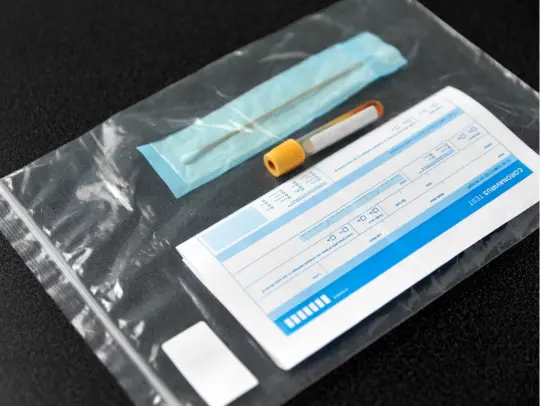
Nurse Practitioner Clarissa - Making a Splash: Is Sex in Water Actually Safe?
Making a Splash: Is Sex in Water Actually Safe?
The idea of getting intimate in water has an undeniable allure. Something about the combination of buoyancy, privacy, and the sheer novelty of an aquatic encounter makes water-based lovemaking a common fantasy. From steamy hot tub encounters to midnight skinny-dipping sessions that evolve into something more, sex in water has been romanticized in countless movies and TV shows.
But is it actually safe? Let's dive deep (pun absolutely intended) into this question with both scientific facts and a healthy splash of reality.
Location, Location, Location: Finding the Right Spot
Before we address the safety aspects, let's acknowledge the obvious: if you're considering getting frisky in a public pool, you're likely breaking several rules and potentially laws. Most public swimming facilities have explicit regulations against sexual activity, and for good reason. Beyond the obvious issues of public decency, there are legitimate health and safety concerns for other patrons.
If aquatic intimacy is on your agenda, consider these location options instead:
- Private pools: If you're fortunate enough to have access to a private pool, this provides both privacy and control over cleanliness.
- Secluded beaches: A remote beach can offer privacy, though be absolutely certain you're not trespassing or violating local regulations.
- Personal hot tubs or bathtubs: These provide the most control over both privacy and cleanliness.
- Hotel pools after hours: Some accommodations offer private pool bookings or have secluded pools attached to certain suites.
A word of caution: Remember that indecent exposure laws exist in most jurisdictions, and getting caught could result in legal consequences ranging from fines to potentially having to register as a sex offender in extreme cases. That romantic water encounter suddenly seems less appealing when it comes with a court date, doesn't it?
The Physical Challenges: Gravity's Revenge
Movies make underwater encounters look effortless and graceful. The reality? Sex in water can be surprisingly awkward and physically challenging for reasons you might not anticipate.
Slips, Trips, and Embarrassing Falls
Water creates slippery surfaces, and when you're engaged in activities that require some stability, this can be problematic. Pool and hot tub surfaces aren't designed with intimate acrobatics in mind. Falls can lead to:
- Sprains and strains
- Head injuries from hitting the side of a pool or tub
- Embarrassing emergency room visits (and explaining how exactly you ended up with that particular injury)
The buoyancy of water also works against you in surprising ways. Positions that are simple on land become physics experiments underwater. Just as you find your rhythm, buoyancy might suddenly lift one partner away from the other at exactly the wrong moment, leading to frustration rather than fulfillment.
The Paradox of Water and Lubrication
Here's a counterintuitive fact that many don't realize until they try: water actually reduces natural lubrication rather than enhancing it. The water washes away the body's natural lubricants, potentially making intercourse uncomfortable or even painful.
This creates what sex educators call "the wet-dry paradox" – you're surrounded by water, yet experiencing uncomfortable dryness where it matters most. This can lead to:
- Micro-tears in sensitive tissues
- Increased friction and discomfort
- Higher risk of condom breakage due to increased friction
If you're determined to make a splash, water-resistant lubricant specifically designed for aquatic activities is an absolute necessity. Regular lubricants will quickly wash away, leaving you back at square one.
The Hidden Dangers: Infection Risks
Besides the physical challenges, water environments present several unique infection risks that dry-land encounters don't.
The Bacterial Soup
Water, particularly warm water in hot tubs or stagnant natural water, can harbor a variety of microorganisms. Some concerning inhabitants include:
- Pseudomonas aeruginosa: Causes hot tub folliculitis, a skin infection that presents as itchy, red bumps.
- E. coli: Potentially present in natural water sources, especially those near agricultural areas.
- Legionella: The bacteria that causes Legionnaires' disease can thrive in improperly maintained hot tubs.
- Candida: Yeast infections can flourish in the warm, moist environment created by prolonged exposure to water.
Even clean-looking water can harbor bacteria, and the risk increases with warmer temperatures – making hot tubs particularly concerning venues for intimate activities.
Chemical Concerns
While bacteria in untreated water is concerning, the chemicals used to combat those pathogens bring their own problems. Chlorine and other pool chemicals can:
- Irritate sensitive genital tissues
- Disrupt vaginal pH balance
- Potentially weaken latex condoms
- Cause general skin irritation with prolonged exposure
These chemical exposures can create the perfect storm for post-coital urinary tract infections, bacterial vaginosis, or yeast infections – particularly unwelcome souvenirs from your aquatic adventure.
Protection Problems: When Condoms Meet Water
If you're using condoms for protection against pregnancy or STIs, water introduces significant complications to their effectiveness.
Durability Issues
Standard condoms aren't designed with underwater use in mind. When exposed to water, especially chlorinated or salt water, latex can:
- Become more prone to tearing
- Slip off more easily due to reduced friction
- Degrade more quickly, especially in hot water
Some manufacturers do make condoms specifically marketed for water use, but even these provide less reliable protection than condoms used in dry conditions. The combination of water-related stress on the material and the potential for reduced sensation leading to rougher intercourse creates a perfect storm for condom failure.
Application Challenges
Just try opening a condom wrapper with wet hands – it's like trying to unwrap a sticker while wearing mittens. The practical aspects of using protection in water can be frustratingly difficult, leading some couples to skip this crucial step entirely.
The Potential Upsides: Is It Worth the Splash?
With all these cautions, you might wonder if aquatic intimacy is worth the effort. There are some potential benefits that keep the fantasy alive for many:
Sensory Enhancement
Water creates a unique sensory environment. The feeling of weightlessness and the gentle resistance of water can create novel sensations that enhance pleasure for some people. The slight buoyancy can make certain positions easier, particularly for partners with mobility challenges or joint pain on land.
Temperature Play
The contrast between water temperature and air temperature (particularly in outdoor settings) can heighten sensitivity. Moving between submersion and exposure creates temperature variations across the skin that some find intensely pleasurable.
The Adventure Factor
Let's not discount the psychological thrill of novelty and mild risk-taking (within legal boundaries, of course). For some couples, simply breaking from routine and trying something adventurous together can enhance intimacy and create memorable shared experiences.
Making Waves Safely: Practical Tips
If you're determined to pursue aquatic adventures despite the challenges, here are some practical tips to minimize risks:
- Choose your location wisely: Private is always better than public, and controlled environments are safer than natural bodies of water.
- Invest in proper protection: Look for condoms specifically designed for water use, and don't rely on them as your sole form of protection if pregnancy is a concern.
- Use plenty of waterproof lubricant: Regular lubricants wash away quickly in water. Silicone-based lubricants designed for water play stay effective longer.
- Keep it simple: Complex positions that work on land may be dangerous in water. Stick to stable, secure positions where neither partner risks slipping or falling.
- Time it right: Limit water exposure before and after intercourse. Consider foreplay in the water but moving to dry land for the main event.
- Clean up properly: Shower with clean water soon afterward, and women may want to urinate after sex to help flush any bacteria from the urethra.
- Stay hydrated: This sounds counterintuitive when surrounded by water, but hot tubs especially can cause dehydration, which isn't conducive to a pleasurable experience.
The Verdict: Splash or Pass?
Is sex in water safe? Like many intimate activities, it exists on a spectrum of risk rather than being simply "safe" or "unsafe." The potential for physical injury, infection, or contraceptive failure is certainly higher than in traditional dry environments. However, with proper precautions, realistic expectations, and a good sense of humor about the inevitable awkward moments, it can be an enjoyable addition to your intimate repertoire.
Perhaps the wisest approach is to enjoy the sensual aspects of water play – the kissing, the touching, the playfulness – while saving the full intimate encounter for dry land afterward. That way, you get the fantasy without most of the complications.
Whatever you decide, remember that the best intimate experiences happen when both partners feel safe, comfortable, and able to communicate openly about what's working and what isn't. Sometimes the sexiest thing isn't the location or position but the willingness to laugh together when things don't go exactly as planned – especially when those plans involve defying both gravity and water physics simultaneously.



























































